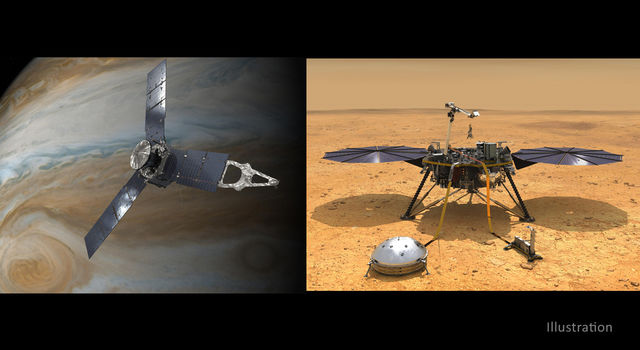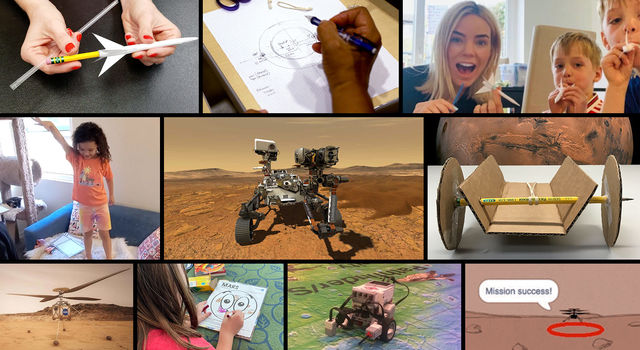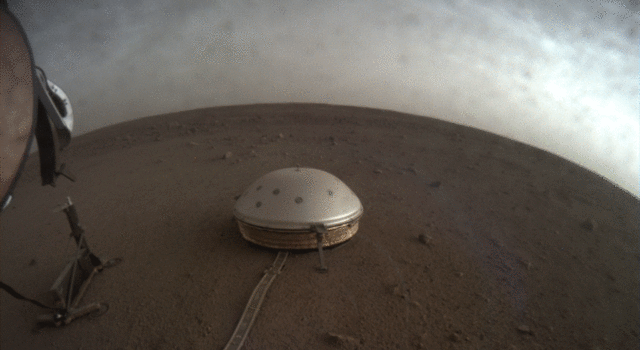Blogs | Dawn Journal | May 29, 2006
May 2006
Dear Dawnologists,
Dawn is making good progress in preparing for its 2007 launch. Let's look forward to some of what must happen during the next year on the most visible part of the Dawn project, the spacecraft, to prepare for its launch. We will discuss other tasks, such as training operations team members, formulating details of the science data acquisition plans, finalizing the software to be used by mission controllers, selecting the ascent trajectory for the rocket, designing Dawn pins, shirts, tattoos, etc., in later logs.
In the previous log (which, it may be revealed with pride, has been nominated for Spam of the Year awards on fewer than 10 planets per galaxy averaged over the full spatial range of readership), it was reported that the spacecraft already was about 90% assembled. It may seem surprising then that Dawn still has a very full Earth-bound year ahead of it. One reason is that attaching any of the sophisticated hardware systems to the spacecraft is a very exacting, and thus time consuming, process.
Most of the units on the spacecraft are complex, expensive, custom-built devices that must be handled with extraordinary care to minimize the risk of damage. In some cases, repair or replacement could take months or even years. Unlike production-line products, such as aircraft, cars, computers, and those nifty thought-controlled confectionery machines that are popular in the Large Magellanic Cloud, the Dawn spacecraft design is being assembled for the first time and there won't be an opportunity for a second chance. That calls for extreme care in every step.
Before any electrical device is connected, a painstaking procedure is followed to verify that all wires carry the signals they are supposed to. We cannot risk that some undetected damage to a connector might create a short circuit or that an error in the wiring, or even in the documentation for the wiring, might lead to too much power being delivered to a sensitive electrical component.
All mechanical connections have to be checked carefully as well, to be sure that they do not place undue stress on other parts that could lead to misalignments of components or structural weakening that might compromise the spacecraft. Every device is attached securely enough to survive launch but not so tightly that something is damaged or distorted.
To reduce the possibility of human error, each step in the long process of assembling the spacecraft is planned and documented in detail. The work executed meticulously by one technician or engineer is observed by another who also carefully inspects the workmanship.
While each of us is eager to get Dawn on its way, rushing this work is unwise. Once it has embarked upon its cosmic travels, repairing any electrical or mechanical problems generally will be extremely difficult or impossible. (During its voyage, Dawn will be more than 1.5 million times farther from Earth than astronauts who work on the International Space Station; emergency roadside assistance will be quite unavailable.) While many mission control teams have accomplished remarkably innovative repairs on remote spacecraft, or learned to work around irreparable damage, expending the effort before launch to prevent problems after launch is the best recipe for success. That brings us to the work that will be the primary focus of the combined Orbital Sciences Corporation/JPL team between now and launch.
Dawn's mission to explore alien worlds we have only glimpsed from afar will be an extremely arduous one, so we will subject the spacecraft to extensive testing to verify that it is up to the challenge. Each component receives a battery of tests during its own assembly before being brought to the spacecraft, but the majority of the testing that awaits Dawn is on the spacecraft as a whole to make sure that all systems work together correctly and perform as intended in their installed configurations.
Most of the rest of this spring (note: all seasons herein refer to Earth's northern hemisphere -- nonresident readers, consult your almanacs) will be devoted to the first set of comprehensive performance tests, putting hardware and software subsystems now on the spacecraft through their paces. (Following the tradition nearly as ancient and revered as nerdiness itself, these tests are generally referred to by an acronym -- CPTs.) In addition to helping establish that the subsystems perform as they are designed to, the first set of CPTs will establish a reference against which to compare the results of subsequent runs of the same CPTs, thereby showing that other tests performed on the spacecraft did not damage it. The CPTs have already been executed on simulators to make sure that they work correctly so that valuable time with the spacecraft is used effectively.
Although the spacecraft is in an environmentally controlled facility (a "clean room," quite unlike my office) most of the systems on it came with a small inventory of chemicals that could contaminate some of the sensitive surfaces when Dawn is in space. Therefore, during the heat of the Dulles, Virginia summer, the spacecraft will be baked for about a week in a vacuum chamber to drive off these undesirable contaminants. (Note: while the chamber will be much hotter than the outdoors at Orbital Sciences, the vacuum will make it less humid than Dulles. Nevertheless, this environment is not recommended even for those who prefer dry heat.) CPTs will be repeated afterwards to verify that no harm was inflicted during the relocation or the baking.
During the gorgeous Virginia autumn, the Dawn team will conduct a series of tests designed to prove that the spacecraft can withstand the environmental conditions it will face during launch. It will be exposed to the thunderous noise that will rumble around it in the rocket as well as vibration, shock waves, and electromagnetic fields.
Despite the inability to predict weather far in advance, the Dawn team already knows that the winter will be a time of great temperature variation. In preparation for what it will experience during spaceflight, the spacecraft will once again be placed in a thermal vacuum chamber, but for much longer than the bake-out. Over the course of about a month, Dawn will experience sweltering heat and biting cold, and it will have to prove that it can operate as designed throughout the range.
While we do not want there to be problems, finding them here on Earth would be far superior to discovering them when Dawn is in the far reaches of deep space. Although human readers might consider all these tests to be punishing in the extreme, it is worth recalling that much of the work in designing the spacecraft was devoted to ensuring that the system would be able to operate under such harsh conditions. The tests over the coming year will give Dawn just a preview of what it will spend most of its productive life experiencing as it strives to accomplish its raison d'être.
Throughout the coming year, certain components will be removed or installed at times planned carefully to fit in the complex campaign to get Dawn safely to space. One simple example is the ion thrusters, the most salient part of the ion propulsion system. Two of the three thrusters project from the spacecraft (see, for example, http://dawn.jpl.nasa.gov/mission/spacecraft.asp and the thrusters depicted in gray on the lower left and right at http://dawn.jpl.nasa.gov/multimedia/images/cylinder_300.jpg), and these precise and delicate devices could be damaged by the highly skilled, albeit human, workers who are performing other tasks on the spacecraft. So mock-ups with the same mass will be used during some of the tests.
For most of the tests, special sensors, such as contamination monitors or accelerometers, will be installed temporarily. Between environmental tests and after the spacecraft is transported from one facility to another, CPTs or, in some cases, more limited performance tests (you guessed it -- LPTs) will be conducted to aid in the assessment of the effects of the test on our robotic explorer.
When Dawn passes all of its tests, it will be rewarded in the same way many humans are: it will take a road trip to Florida for spring vacation. Not far from the warm waters and sandy beaches of Cape Canaveral, Dawn will be given the final tests to verify that it was not harmed in shipment. The ion propulsion system's xenon tank will be filled with 425 kg (937 pounds) of xenon, and the reaction control system (used to help rotate the spacecraft, but not to propel it to Vesta and Ceres) will be loaded with about 45 kg (100 pounds) of hydrazine propellant. There will be flurry of other activity as well, as Dawn presents its last opportunity to be tested and readied for flight. Of course, the plan is for Dawn to leave Florida by a very different route from the one by which it arrived.
Dawn will have an exciting adventure after launch as it travels through the solar system, some of the time without company and some with Vesta or with Ceres. But its last trip around the Sun while still on its planet of origin will be no less busy.
Dr. Marc D. Rayman
May 29, 2006
TAGS:DAWN, VESTA, CERES, DWARF PLANET, MISSION, SPACECRAFT







